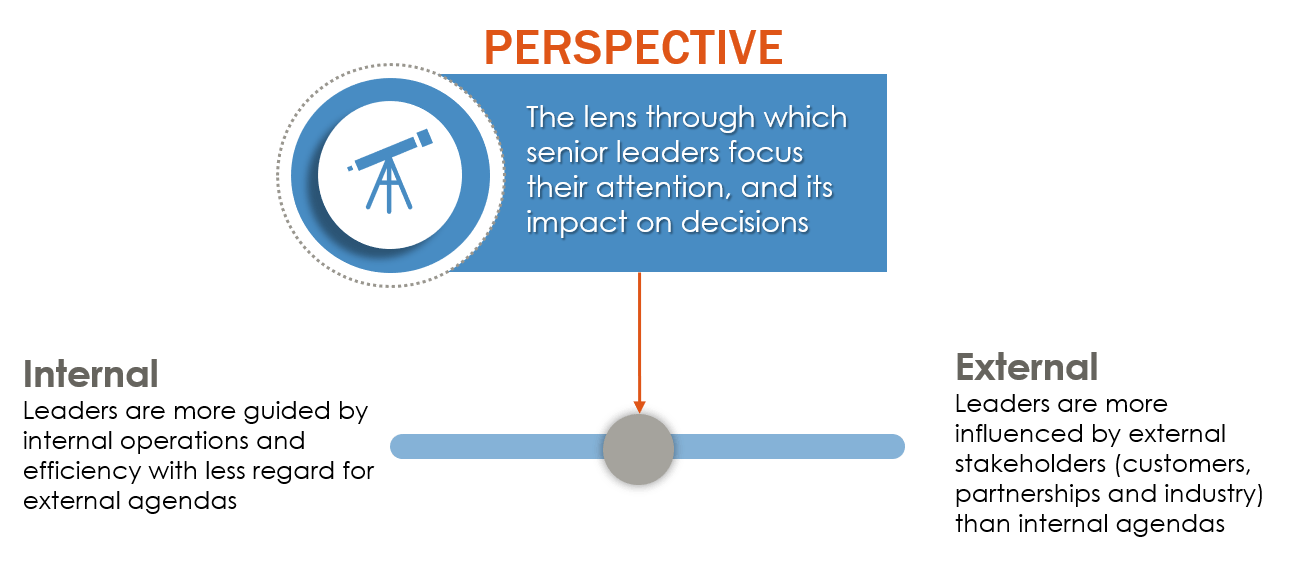Starting in the late 1980s and continuing through the beginning of the new millennium, many organizations were focused on process improvement, cutting costs, and creating efficiencies; leaders were forced to focus internally. Massive undertakings in process-reengineering, outsourcing, and the building of captive facilities in new or emerging markets (mostly to address the needs for customer service/contact centers and/or technology development) perpetuated this internal focus for decades.
The Secret 7 Culture Conversation #2 of 7: PERSPECTIVE
Dave Eaton, Partner of The Clarion Group, Ltd. • July 13, 2020

“Naval-gazing” and “myopic” are two phrases often used to describe insular, internally focused, and inward-looking organizations. Of course, leaders must take care of their people, be empathic to the employee experience, and focus on improving and
strengthening internal processes. These are all critical steps in building a high-performance organization.
However, leaders also need to constantly look out ahead, anticipating customer needs, trends in the industry, and market forces that can have an impact on not only their customers, but also their relevance as a provider of certain products and services.
strengthening internal processes. These are all critical steps in building a high-performance organization.
However, leaders also need to constantly look out ahead, anticipating customer needs, trends in the industry, and market forces that can have an impact on not only their customers, but also their relevance as a provider of certain products and services.
Zoom forward to the modern era. Customers expect multiple options for availing themselves of a company’s products and services, forcing many leaders to re-think their platforms, if not their entire business model. Just think about the rapid shift to e-commerce over the past few months. Despite ongoing uncertainty and economic challenges, leaders today must “take their heads up out of the sand” and focus their attention on the future if their organizations stand a chance of winning. Bluntly, they must carefully consider the challenges their customers/clients may face down the road, and innovatively solve these challenges.
An equally difficult conversation being had in boardrooms, C-suites, break rooms, and after-work bars alike, is whether an organization is showing up as more margin-driven or mission/purpose-driven. We know this is a painful dilemma for leadership teams to wrestle with. At a recent academic medical center in Boston, we heard the statement uttered several times during our culture transformation work: “No margin, no mission.”
We would like to release top leadership from this “either-or” choice. Time to have it all! How can the organization lay out a plan to be able to achieve its mission/purpose, while still producing a meaningful profit margin at the end of the day? The answer is not only “it can!” but “it must.” The challenge comes not from the “what” (this is non-negotiable mission/purpose), but the “how” (this is the somewhat fluid tactical plan).
The most impressive organizations we have followed, some of which we have had the privilege to work with, have figured out how to balance the two, and achieve both. It often comes down to being resolute on one’s values and purpose, and never compromising these at any intersection…ever. When making decisions or prioritizing resources, high-performing organizations with enviable cultures seem to make the right
choices with these “keystones of culture” (mission/purpose, vision, and values) as their litmus test every step of the way.
What drives an organization to greatness, in this regard, is to be situational in their choices, over mere consistency. It is critical for the leadership team to enable the rest of the organization by empowering them to make smart choices based on the situation they find themselves in at any given moment.
For example, even though an organization has decided to launch a certain product, with a well-conceived marketing strategy, it must allow local geographies to customize the approach they take based on their local knowledge of their unique market. Better yet, leaders should invite a cross-representation of all markets to the original table where they are developing the global market strategy, so when they land back in their local market, they “own” the campaign and can implement their localized version for what makes sense to their local/regional customers.
Tremendous progress can be made when an organization has the ability to release the control from the top, where status-quo often lives, and allow for “out-of-the-box” thinking and new and creative ideas to flourish. Some of the best and most innovative ideas come from outside perspectives, customer focus groups, listening to our clients’ needs and especially from new and younger employees who have their own unique perspectives.
In summary, leaders must be willing to release the need to control by sticking to the organization’s historical ways. The organization can always return to tried and true methods – these are well-known, and they still may be the best choice. But leaders must make sure the situation and key constituent groups drive a majority of decisions. And they must listen; listen to employees, listen to customers; listen to the “street” – memorize the messages being imparted. This can unleash a whole new perspective on the organization’s go-forward strategy and tactics of implementation.
For more information on The Secret 7, or if you would like to receive a unique survey link (custom URL), free for your company/organization, please click here and complete the form.
An equally difficult conversation being had in boardrooms, C-suites, break rooms, and after-work bars alike, is whether an organization is showing up as more margin-driven or mission/purpose-driven. We know this is a painful dilemma for leadership teams to wrestle with. At a recent academic medical center in Boston, we heard the statement uttered several times during our culture transformation work: “No margin, no mission.”
We would like to release top leadership from this “either-or” choice. Time to have it all! How can the organization lay out a plan to be able to achieve its mission/purpose, while still producing a meaningful profit margin at the end of the day? The answer is not only “it can!” but “it must.” The challenge comes not from the “what” (this is non-negotiable mission/purpose), but the “how” (this is the somewhat fluid tactical plan).
The most impressive organizations we have followed, some of which we have had the privilege to work with, have figured out how to balance the two, and achieve both. It often comes down to being resolute on one’s values and purpose, and never compromising these at any intersection…ever. When making decisions or prioritizing resources, high-performing organizations with enviable cultures seem to make the right
choices with these “keystones of culture” (mission/purpose, vision, and values) as their litmus test every step of the way.
What drives an organization to greatness, in this regard, is to be situational in their choices, over mere consistency. It is critical for the leadership team to enable the rest of the organization by empowering them to make smart choices based on the situation they find themselves in at any given moment.
For example, even though an organization has decided to launch a certain product, with a well-conceived marketing strategy, it must allow local geographies to customize the approach they take based on their local knowledge of their unique market. Better yet, leaders should invite a cross-representation of all markets to the original table where they are developing the global market strategy, so when they land back in their local market, they “own” the campaign and can implement their localized version for what makes sense to their local/regional customers.
Tremendous progress can be made when an organization has the ability to release the control from the top, where status-quo often lives, and allow for “out-of-the-box” thinking and new and creative ideas to flourish. Some of the best and most innovative ideas come from outside perspectives, customer focus groups, listening to our clients’ needs and especially from new and younger employees who have their own unique perspectives.
In summary, leaders must be willing to release the need to control by sticking to the organization’s historical ways. The organization can always return to tried and true methods – these are well-known, and they still may be the best choice. But leaders must make sure the situation and key constituent groups drive a majority of decisions. And they must listen; listen to employees, listen to customers; listen to the “street” – memorize the messages being imparted. This can unleash a whole new perspective on the organization’s go-forward strategy and tactics of implementation.
For more information on The Secret 7, or if you would like to receive a unique survey link (custom URL), free for your company/organization, please click here and complete the form.

We’ve seen many organizations shifting their command and control, autocratic and authoritative leadership style to one that fosters collaboration, often through taking risks, empowering their people and their teams, and welcoming the dissonance that comes from breaking down silos and allowing for horizontal, cross-functional teams to form.

In the context of organizational culture, “time” is defined as the priority people place on time vs. relationships, and in our experience, organizations that “get it right” more often than not enjoy greater success. Many clients over the years have challenged us as to whether they need to choose between the two ends of this dimension. “No, you don’t.” But you do need to know when to play each end of the culture dimension of time to get the best results.

Imagine a culture where all ideas are welcome, even the crazy and “out of the box” ones, where employees feel safe to ask the question, “Have we ever thought about X before?” A work environment in which senior leaders create a “no idea is a dumb idea” environment such that teams come together, brainstorm new ways of looking at organization-wide problems, and create breakthrough ideas together?

As the momentum of the Black Lives Matter movement continues to grow, I have been struck by how companies are responding to it. Most are openly acknowledging the unintentional complicity of their own organizations in perpetuating the issues; implicit biases are being illuminated like never before. I am impressed by how this movement that is challenging systemic (i.e., across the “ecosystem”) biases is unearthing the core of our implicit biases. The broader context from which this heightened awareness has spawned has come about, I think, from the collision of many forces that are culminating to create one giant breaking wave: confusing and divisive messages from the U.S. administration, pent up isolation and angst from COVID-19, an economy that has heightened the disparity between the “have and have nots,” positive overseas relationships with allies turning adversarial, and so much more. Metaphorically, these forces, strengthened by mass-impact movements such as Black Lives Matter, have created a huge pile of dry kindling; the death of George Floyd (following way too many others) was perhaps the spark that ignited the bonfire now burning. Companies today have three choices to make in response to the challenge so well-articulated by the Black Lives Matter movement: Do nothing, assuming “this too shall pass.” Assess, and where needed, adapt their own internal culture and operating environment in ways that surface and eliminate implicit biases. Embrace the work in choice #2 WHILE CONCURRENTLY : Developing holistic clarity around how, as a player in society, the organization is knowingly – or unknowingly – perpetuating biases, racist principles, and divisive behavior in their marketplaces; and then Making the changes needed, accepting that pillars so foundational as mission, vision, and values may be at stake. I am optimistic that the Black Lives Matter movement is going to make a difference – ideally at the systemic level but at least at a “dent” level. So many company leaders with whom we’ve worked have chosen #3 as the necessary course to follow. This is encouraging as it reflects broad recognition that the organization’s contribution to societal change requires both “inside” and “outside focus.” In our experience, working with literally hundreds of leaders, most organizations had begun the journey towards creating truly diverse and inclusive cultures some time ago; the fires now have accelerated those efforts, prompting deeper consideration into areas such as: Talent Management : How is our leadership team “mapping” (from a diversity perspective) to our customer base, employee base, and the communities we serve/operate in? Leadership Principles : Have we reviewed our leadership principles and considered development strategies/learning to ensure we are building the muscle required of our leaders to be inclusive leaders, who also stretch themselves to form diverse-by-design teams intentionally to broaden the unique perspectives brought to a business problem or opportunity? Today we see leaders and their organizations examining with real scrutiny “who they be” with their customers, partners, and shareholders: How are we selecting the market segments to do business with? Why? Do these choices harmfully exclude others from our products/services? Have we reviewed our approach to supplier management and selection and considered any implicit bias or leanings based on historical relationships only? Who do we recruit and select to represent us in the marketplace, either our employees, agents, distributors, or sales representative agencies? Are we too aggressively going after the segments where we can maximize profits or are we balancing the need to make money with the needs of all of society? How do we best reset our strategic choices on the ways we interact with the marketplace so as to not perpetuate implicit bias and exclusion? We should all applaud the companies that are pursuing this much bolder and harder path. It is not lipstick on the pig; it is holistic and systemic change. It will take years of concerted effort, millions of dollars, and great courage to stay the course to fully operationalize the principles of diversity, equity, and inclusion. Patience is needed but inaction is unacceptable. For the companies being heralded, we should expect to see steps of progress while always remembering that lasting systemic change will take time.

In response to the human emotions around coping with COVID-19, the Harvard Business Review (HBR) recently published an interview* with David Kessler, a globally respected expert on the stages of emotional response when confronting negatively perceived change (ultimately, death) initially formulated by Elizabeth Kubler-Ross. (Clarion founder and my partner, Bill McKendree, published a good piece last week on this: Times of Crisis Call for Leadership Heart ). With Kubler-Ross’ family’s agreement, Kessler postulated the presence of a sixth and final stage beyond acceptance – finding meaning. I think that finding meaning in the face of such loss of human life and economic devastation crosses over into a profoundly human spiritual dimension. That HBR would have the courage to enter that dimension is somewhat astonishing. But it is also an accurate and insightful acknowledgement that COVID-19 has erased any artificial boundaries between business and humanity. It is a door opened that I now walk through cautiously. It seems obvious that in past times we would have looked to spiritual leaders for the kind of guidance sought in the face of grief, death and dying. Here, now, in the face of a global pandemic, the stage for spiritual leadership feels very, very empty. Sadly, the divisiveness that rips across a complicated mixture of ethnic groups and religious sects, clinging to seemingly irrelevant historical and political conflicts, undermines the ability of any one religiously affiliated person to represent us all, to speak to us individually, to touch our hearts directly. How then do we find even the slightest thread of meaning that is in fact by its very nature fundamentally spiritual, but does not say so in a way that alienates any one of our fellow employees? Or our customers? Our neighbors? Our friends? Perhaps it is just me, but there is something about the nature of COVID-19 that I cannot help but feel is speaking to us all, collectively, in a single, unifying voice. We are all human. We are all vulnerable. We are all able to help. We are all in this together. Right now , that alone is meaningful. If a virus can view us this way, why can we not view ourselves this way? Our survival may depend upon it, and yet we remain stuck in our separateness. We are our own worst enemies. If it helps, then see this “meaning” as coming from a purely scientific view, not a religious view. At one level it is more important that we just see it. But truth be told, it is not one or the other. As seen by a scientist, it is both:

Leaders today are being asked to step up to a challenge few ever imagined. There simply is no playbook for leading through COVID-19. Carefully crafted strategic plans have suddenly become irrelevant, and leadership teams across the globe have moved into aggressive downsizing in anticipation of an unprecedented economic slowdown. We’ve talked to a lot of our clients over the past week. The block and tackle of re-forecasting is well underway, but most are privately feeling alone and simply unsure of how to approach the “soft side of business” – keeping employees settled and engaged. Times of crisis call for heart. And heart starts with understanding how employees’ needs have changed; for many, needs have changed dramatically. With the “silent enemy” now among us, the cadence of life has been significantly altered: work-from-home, children out of school, elderly parents to care for, and illnesses to manage, often while we are trying to come to terms with the real financial impact many are experiencing. Leaders, consider this: in a crisis, humans revert down Maslow’s Hierarchy of Needs, focusing on the basics: safety, security and health. Project deliverables, reports, and even the economic viability of the organization will for most take a backseat to individual concern for personal and family well-being and financial security.






